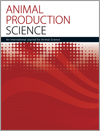
Animal Production Science
Volume 63 Number 9 2023
Wellbeing is an outcome of feeling, functioning and interacting well. Every day, animals need to cope with fluctuations in their environment that tax their homeostatic integrity. Daily patterns in biorhythms, production, and complexity of behaviours monitored in real time or archived in stable tissues of the body are reviewed as potential indicators of functional integrity. It is suggested that indicators of functional integrity can help inform wellbeing assessments and contribute to assurance of the quality of life experienced by livestock.
AN23029 Abstract | AN23029 Full Text | AN23029PDF (2 MB) Open Access Article
AN21581Effect of minor allele frequency and density of single nucleotide polymorphism marker arrays on imputation performance and prediction ability using the single-step genomic Best Linear Unbiased Prediction in a simulated beef cattle population
 , Elisa Peripolli
, Elisa Peripolli  , Marisol Londoño-Gil
, Marisol Londoño-Gil  , Rafael Espigolan
, Rafael Espigolan  , Raysildo Barbosa Lôbo
, Raysildo Barbosa Lôbo  , Rodrigo López-Correa
, Rodrigo López-Correa  , Ignacio Aguilar
, Ignacio Aguilar  and Fernando Baldi
and Fernando Baldi 
To make genomic selection feasible at a commercial scale in beef cattle, it is common practice to obtain genomic predictions from imputed genotypes in different single nucleotide polymorphism arrays. Using simulated data and single-step genomic Best Linear Unbiased Prediction, we evaluated prediction ability and imputation performance of moderate to low-density customised arrays, selecting markers with different minor allelic frequency available from high-density arrays. Cost-effective and robust genomic predictions may be achieved for beef cattle with moderate to low-density arrays.
L-citrulline does not degrade in the rumen and has the ability of peptide bond formation in the body, but does not participate in protein synthesis. Its effects on amino acids, hormones, antioxidant capacity in plasma, and reproductive performance of ewes were studied by feeding them with varying doses of L-Cit. The lambing rate and double lambing rate of ewes increased when the dose of supplementary feed was 10 g/day.
Cassava root can be an acceptable energy source for poultry, but its dietary recommendations have been variable. Low protein content, deficiency in sulfur amino acids, presence of cyanide and dustiness are the major constraints to the efficient utilisation of cassava meal in poultry diets. Adequately processed cassava root and moringa leaf supplemented with vegetable oil in isocaloric and isonitrogenous diets can replace up to 45% of dietary maize for broilers and reduce production cost.
AN22367Acclimation of replacement gilts to Mycoplasma hyopneumoniae: a case study of fogging with an aerosol inoculum
 , David D. E. S. N. Barcellos
, David D. E. S. N. Barcellos  , Rafael R. Ulguim
, Rafael R. Ulguim  , Taís R. Michaelsen, João P. Zuffo, Mariana S. Goslar, Giovani R. Michelleto, Jonatas Wolf, Fernando P. Bortolozzo
, Taís R. Michaelsen, João P. Zuffo, Mariana S. Goslar, Giovani R. Michelleto, Jonatas Wolf, Fernando P. Bortolozzo  and Karine L. Takeuti
and Karine L. Takeuti 
Mycoplasma hyopneumoniae is the causative agent of enzootic pneumonia, responsible for significant economic losses to pig production worldwide. One of the control strategies is the acclimation of replacement gilts prior to their entry to the farm, which was the aim of this case study. Our results showed that the use of fogging with a positive inoculum of M. hyopneumoniae is capable of acclimating gilts, and could be a useful tool to control enzootic pneumonia in gilts.
AN22366Lime, phosphorus and stocking rate of an extensively managed permanent pasture affect feed-on-offer, sheep growth rate, carrying capacity and wool production
 , Denys L. Garden, Maheswaran Rohan
, Denys L. Garden, Maheswaran Rohan  , Beverley A. Orchard, Philip Armstrong and Trent Brassil
, Beverley A. Orchard, Philip Armstrong and Trent Brassil
Soil acidity is a serious problem reducing the production of pastures and grazing animals. Although lime can reduce acidity, it is expensive, because high rates are required. This research studied the effects of lime and superphosphate on pasture and sheep production. The higher pasture productivity of the high-lime, high-phosphorus treatments enabled higher stocking rates, sheep growth rates and wool production compared with the nil lime control, indicating the value of lime application.
AN22366 Abstract | AN22366 Full Text | AN22366PDF (1.7 MB) Open Access Article
Cumin is a common spice used for enhancement of flavour. It has preservative potential as a natural antioxidant and antimicrobial agent in meat model system. It may be an alternative to synthetic/chemical preservatives in meat products. The findings of this research indicated that inclusion of cumin oil reduced deterioration of physicochemical quality, improved antioxidant capacity, and decreased lipid oxidation and microbial proliferation together with acceptable sensory attributes in meat emulsion at 0.75% level.
Body size data is an important indicator for evaluating the health and breeding of pigs. This study proposes a fast and accurate body size estimation method, which can identify the body length, width and body height of pigs without contact through the captured image data. It provides technical support for pig automation and welfare breeding.



